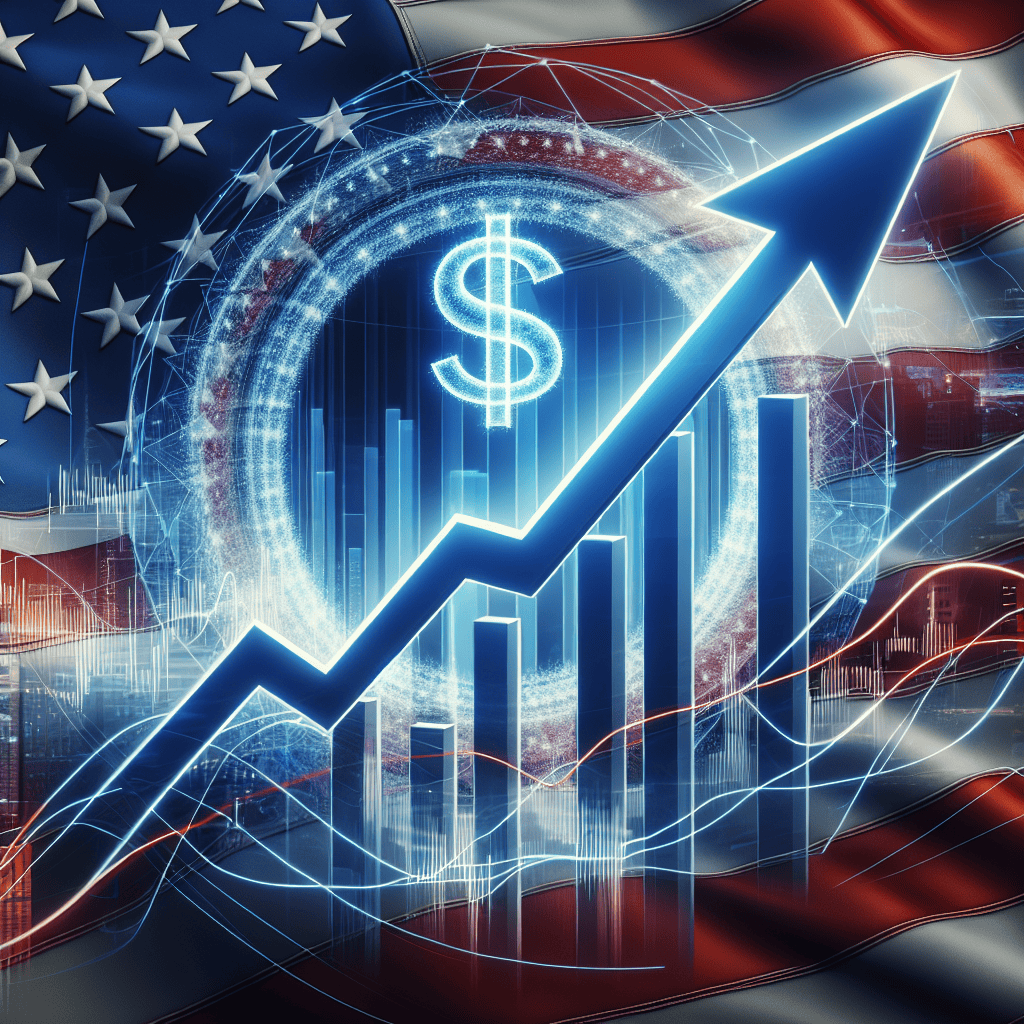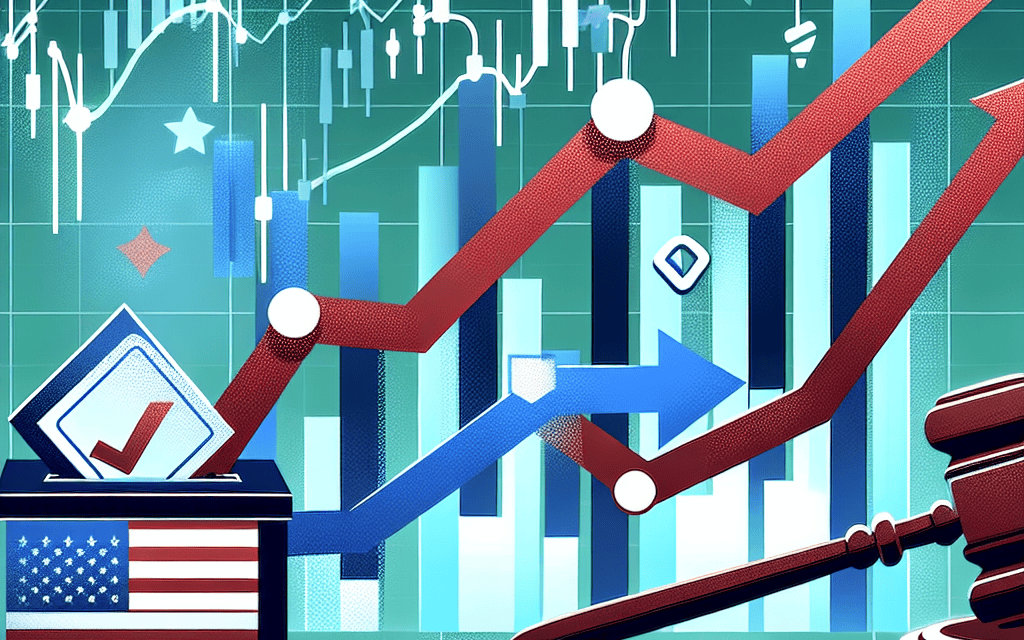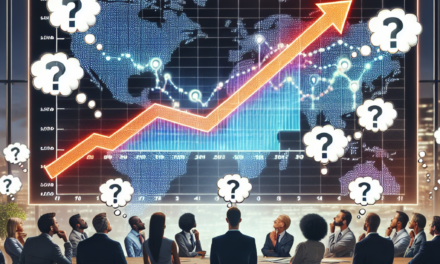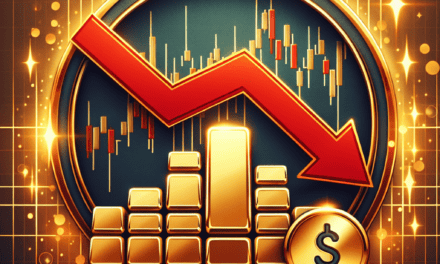“Markets Poised: Navigating the Crossroads of US Elections and Fed Decisions”
Introduction
Futures markets are experiencing an upswing as investors keenly anticipate two pivotal events: the upcoming U.S. elections and the Federal Reserve’s impending decision on interest rates. These developments are poised to significantly influence market dynamics, with traders closely monitoring potential shifts in economic policy and political landscape. The elections could reshape legislative priorities, impacting sectors from healthcare to technology, while the Fed’s rate decision will be scrutinized for signals on inflation management and economic growth. As these events unfold, market participants are positioning themselves to navigate the potential volatility and capitalize on emerging opportunities.
Impact Of US Polls On Global Financial Markets
As the world closely watches the unfolding political landscape in the United States, the anticipation surrounding the upcoming polls and the Federal Reserve’s rate decision has begun to ripple through global financial markets. Investors and analysts alike are keenly aware that these events could significantly influence market dynamics, both domestically and internationally. The interplay between political developments and monetary policy decisions is poised to shape investor sentiment and market trajectories in the coming months.
The U.S. polls, a critical barometer of political sentiment, have historically had a profound impact on financial markets. As the world’s largest economy, the United States plays a pivotal role in global trade and investment flows. Consequently, any shifts in its political landscape can reverberate across borders, affecting market stability and investor confidence. The anticipation of potential policy changes, depending on the election outcomes, adds a layer of complexity to market forecasts. Investors are particularly attentive to how these changes might influence fiscal policies, regulatory frameworks, and international trade agreements.
In tandem with the political developments, the Federal Reserve’s impending rate decision is another focal point for market participants. The Fed’s monetary policy stance is a critical determinant of economic conditions, influencing everything from borrowing costs to consumer spending. As inflationary pressures persist and economic indicators fluctuate, the Fed’s decision on interest rates will be scrutinized for its implications on economic growth and financial stability. A rate hike could signal the Fed’s commitment to curbing inflation, but it might also raise concerns about slowing economic momentum. Conversely, maintaining current rates could be interpreted as a move to support continued economic expansion, albeit with the risk of exacerbating inflationary trends.
The intersection of these two significant events—the U.S. polls and the Fed’s rate decision—creates a complex environment for global financial markets. Investors are navigating a landscape marked by uncertainty, where geopolitical considerations and economic indicators are inextricably linked. The potential for volatility is heightened as market participants attempt to gauge the likely outcomes and their subsequent impact on asset prices. In this context, futures markets have emerged as a barometer of investor sentiment, reflecting expectations and hedging strategies in response to anticipated developments.
Moreover, the global nature of financial markets means that the effects of U.S. political and monetary policy decisions are not confined to domestic borders. International investors are acutely aware of the interconnectedness of economies and the potential for spillover effects. For instance, changes in U.S. interest rates can influence capital flows, exchange rates, and investment decisions in other countries. Similarly, shifts in U.S. trade policies can have far-reaching implications for global supply chains and economic growth prospects.
In conclusion, the anticipation of the U.S. polls and the Federal Reserve’s rate decision underscores the intricate relationship between political developments and financial markets. As investors brace for potential shifts in policy and economic conditions, the global financial landscape remains in a state of flux. The outcomes of these events will likely set the tone for market movements in the near term, with implications that extend beyond U.S. borders. As such, market participants are advised to remain vigilant, adapting their strategies to navigate the evolving landscape and mitigate potential risks.
How The Federal Reserve’s Rate Decision Influences Futures
As the financial world keenly anticipates the upcoming U.S. polls and the Federal Reserve’s rate decision, futures markets are experiencing a notable rise. This upward trend is not merely a reflection of investor optimism but also a complex interplay of economic indicators, market sentiment, and policy expectations. Understanding how the Federal Reserve’s rate decision influences futures is crucial for investors seeking to navigate these turbulent waters.
The Federal Reserve, as the central bank of the United States, plays a pivotal role in shaping economic policy through its control over interest rates. When the Fed adjusts these rates, it sends ripples across financial markets, affecting everything from stock prices to bond yields. Futures contracts, which are agreements to buy or sell an asset at a predetermined price at a specified time in the future, are particularly sensitive to such changes. This sensitivity arises because interest rates directly impact the cost of borrowing and the potential return on investment, both of which are critical factors in futures pricing.
In anticipation of the Fed’s rate decision, investors often adjust their positions in futures markets. A potential rate hike, for instance, might lead to a decrease in futures prices as higher borrowing costs could dampen economic growth and corporate profits. Conversely, a rate cut might boost futures prices by making borrowing cheaper and stimulating economic activity. Thus, the Fed’s monetary policy decisions are closely watched by market participants who seek to predict and capitalize on these movements.
Moreover, the timing of the Fed’s rate decision in relation to the U.S. polls adds another layer of complexity. Political events can significantly influence market sentiment, as changes in government policies can alter economic forecasts. Investors often look for clues in the political landscape that might indicate future fiscal policies, which in turn can affect the Fed’s approach to interest rates. For instance, a government perceived as fiscally conservative might lead to expectations of tighter monetary policy, while a more liberal administration might suggest looser monetary conditions.
In this context, the rise in futures amid anticipation of the U.S. polls and the Fed’s rate decision can be seen as a reflection of investor expectations. Market participants are likely weighing the potential outcomes of the elections and their implications for fiscal policy, alongside the Fed’s likely response to evolving economic conditions. This dynamic creates a complex web of factors that influence futures prices, making it essential for investors to stay informed and agile.
Furthermore, the global economic environment also plays a role in shaping the Fed’s decisions and, by extension, futures markets. Factors such as international trade tensions, geopolitical risks, and global economic growth can all impact the Fed’s assessment of the U.S. economy and its subsequent policy actions. As such, investors must consider not only domestic but also international developments when evaluating futures markets.
In conclusion, the interplay between the Federal Reserve’s rate decision and futures markets is a multifaceted relationship influenced by a myriad of factors. As investors navigate the anticipation surrounding the U.S. polls and the Fed’s upcoming decision, understanding these dynamics is crucial. By staying attuned to both economic indicators and political developments, market participants can better position themselves to respond to the inevitable fluctuations in futures prices. This informed approach is essential for those seeking to capitalize on the opportunities presented by these pivotal events.
Analyzing The Correlation Between Political Events And Market Trends
As the financial world braces for the upcoming U.S. polls and the Federal Reserve’s rate decision, futures markets are experiencing a notable uptick. This phenomenon underscores the intricate relationship between political events and market trends, a dynamic that has long intrigued economists and investors alike. Understanding this correlation requires a nuanced examination of how political developments can influence investor sentiment and, consequently, market behavior.
To begin with, political events such as elections often introduce a degree of uncertainty into the markets. Investors, who typically prefer stability and predictability, may react to the potential for policy changes that could impact economic conditions. For instance, different political parties may have varying approaches to taxation, regulation, and government spending, all of which can significantly affect corporate profitability and economic growth. As a result, futures markets, which are inherently forward-looking, tend to fluctuate in anticipation of these potential shifts in policy.
Moreover, the Federal Reserve’s rate decisions are another critical factor that intertwines with political events to shape market trends. The Fed’s monetary policy, particularly its stance on interest rates, plays a pivotal role in determining the cost of borrowing and the availability of credit. When the Fed signals a rate hike, it often aims to curb inflation, but this can also lead to higher borrowing costs for businesses and consumers, potentially slowing economic growth. Conversely, a rate cut is generally intended to stimulate economic activity by making borrowing cheaper. Therefore, the timing of the Fed’s decisions, especially when coinciding with major political events, can amplify market reactions.
In the current scenario, the anticipation of the U.S. polls adds an additional layer of complexity. Investors are closely monitoring the political landscape, as the outcome could have far-reaching implications for domestic and international economic policies. The interplay between the election results and the Fed’s rate decision is particularly significant, as it could set the tone for the economic environment in the near term. For example, a government perceived as business-friendly might boost investor confidence, leading to a rally in futures markets. On the other hand, uncertainty or a perceived shift towards less favorable economic policies could result in market volatility.
Furthermore, historical data suggests that markets often exhibit heightened sensitivity during election cycles. This is partly due to the media’s focus on political developments, which can influence public perception and investor behavior. The constant flow of information, ranging from opinion polls to policy debates, can create a volatile environment where market participants react swiftly to new data. Consequently, futures markets may experience increased trading volumes and price swings as investors attempt to position themselves advantageously ahead of potential policy changes.
In conclusion, the rise in futures amid the anticipation of U.S. polls and the Fed rate decision highlights the complex interplay between political events and market trends. Investors must navigate this landscape with a keen understanding of how political developments can impact economic policies and, by extension, market dynamics. As the financial world watches closely, the outcomes of these events will likely provide valuable insights into the ongoing relationship between politics and markets, offering lessons for future investment strategies. Through careful analysis and strategic positioning, investors can better manage the risks and opportunities presented by this ever-evolving landscape.
Investor Sentiment: Navigating Uncertainty During Election Periods

Investor sentiment often experiences heightened volatility during periods of political and economic uncertainty, and the current anticipation surrounding the upcoming US polls and the Federal Reserve’s rate decision is no exception. As futures rise, market participants are keenly observing the interplay between these two significant events, which are poised to shape the financial landscape in the coming months. Historically, election periods have been characterized by fluctuating investor confidence, as market participants attempt to gauge the potential impact of political outcomes on economic policies and, consequently, on their investment portfolios.
The anticipation of the US polls introduces a layer of complexity to the investment environment. Investors are acutely aware that election results can lead to shifts in fiscal policy, regulatory changes, and alterations in international trade agreements. These potential changes can have far-reaching implications for various sectors, influencing corporate earnings and market valuations. As a result, investors often adopt a cautious approach, seeking to balance risk and reward while navigating the uncertainty that accompanies election cycles. This cautious sentiment is reflected in the rising futures, as investors position themselves to capitalize on potential market movements while hedging against adverse outcomes.
Simultaneously, the Federal Reserve’s impending rate decision adds another dimension to the current investment climate. The Fed’s monetary policy plays a crucial role in shaping economic conditions, influencing borrowing costs, consumer spending, and business investment. In recent months, the central bank has been navigating a delicate balance between supporting economic growth and curbing inflationary pressures. Investors are closely monitoring the Fed’s communications for any indications of future rate adjustments, as these decisions will have a direct impact on market liquidity and asset prices.
The intersection of these two events creates a unique environment for investors, who must weigh the potential outcomes of the US polls against the backdrop of the Fed’s monetary policy stance. This dual focus requires a nuanced understanding of both political and economic factors, as well as their potential interactions. For instance, a change in political leadership could lead to shifts in fiscal policy that either complement or counteract the Fed’s monetary objectives. Consequently, investors must remain vigilant, continuously reassessing their strategies in response to new information and evolving market conditions.
In navigating this period of uncertainty, investors may benefit from a diversified approach, spreading their investments across various asset classes and geographies to mitigate risk. Additionally, maintaining a long-term perspective can help investors weather short-term volatility, as markets often stabilize once the outcomes of major events become clearer. By focusing on fundamental analysis and maintaining a disciplined investment strategy, investors can better position themselves to capitalize on opportunities that arise during periods of uncertainty.
In conclusion, the anticipation of the US polls and the Federal Reserve’s rate decision presents a challenging yet potentially rewarding environment for investors. As futures rise, reflecting cautious optimism, market participants must remain attuned to the dynamic interplay between political and economic factors. By adopting a strategic approach and staying informed, investors can navigate the uncertainty of election periods and make informed decisions that align with their financial goals. As the situation unfolds, the ability to adapt and respond to changing conditions will be crucial in achieving investment success.
The Role Of Central Banks In Stabilizing Markets Amid Political Changes
As global markets brace for the upcoming U.S. elections and the Federal Reserve’s impending rate decision, the role of central banks in stabilizing markets amid political changes has never been more crucial. Central banks, with their ability to influence monetary policy, play a pivotal role in maintaining economic stability during periods of political uncertainty. This is particularly evident as futures rise in anticipation of these significant events, reflecting investor sentiment and market expectations.
Central banks, such as the Federal Reserve in the United States, the European Central Bank, and the Bank of Japan, are tasked with the dual mandate of controlling inflation and fostering economic growth. In times of political change, these institutions often find themselves at the forefront of efforts to stabilize financial markets. The anticipation of U.S. polls, for instance, can lead to market volatility as investors attempt to predict the economic policies of potential new administrations. In such scenarios, central banks may intervene by adjusting interest rates or employing other monetary tools to mitigate market fluctuations and reassure investors.
Moreover, the Federal Reserve’s rate decision is a critical factor that influences market dynamics. Interest rates set by the Fed affect borrowing costs, consumer spending, and business investment, thereby impacting overall economic activity. As futures rise in anticipation of the Fed’s decision, it underscores the market’s sensitivity to monetary policy changes. A rate hike, for example, might signal confidence in economic growth, while a rate cut could be interpreted as a measure to stimulate a sluggish economy. Thus, the Fed’s actions are closely monitored by investors who seek to align their strategies with the central bank’s policy direction.
In addition to interest rate adjustments, central banks employ various tools to stabilize markets. Quantitative easing, for instance, involves the purchase of government securities to increase the money supply and encourage lending and investment. This approach can be particularly effective during periods of political uncertainty, as it provides liquidity to the financial system and supports economic activity. Furthermore, central banks often engage in forward guidance, communicating their policy intentions to the public to manage expectations and reduce market volatility.
The interplay between political changes and central bank actions is complex and multifaceted. Political events, such as elections, can lead to shifts in fiscal policy, trade relations, and regulatory frameworks, all of which have implications for economic stability. Central banks, therefore, must remain vigilant and responsive to these changes, adjusting their policies as necessary to maintain market confidence and economic resilience.
In conclusion, the role of central banks in stabilizing markets amid political changes is indispensable. As futures rise in anticipation of U.S. polls and the Federal Reserve’s rate decision, it highlights the critical influence of monetary policy on market sentiment and economic stability. Through interest rate adjustments, quantitative easing, and forward guidance, central banks strive to navigate the challenges posed by political uncertainty, ensuring that financial markets remain robust and economies continue to thrive. As such, their actions are not only pivotal in the short term but also in shaping the long-term trajectory of global economic growth.
Strategies For Traders: Preparing For Volatility During Key Economic Events
As traders navigate the complex landscape of financial markets, the anticipation of key economic events such as US elections and Federal Reserve rate decisions often brings heightened volatility. Understanding how to strategically prepare for these fluctuations is crucial for both seasoned and novice traders. The interplay between political developments and monetary policy decisions can significantly impact market sentiment, leading to rapid price movements that present both opportunities and risks.
To begin with, it is essential for traders to stay informed about the timing and potential implications of these events. The US elections, for instance, can lead to shifts in fiscal policy, regulatory changes, and international relations, all of which can influence market dynamics. Similarly, the Federal Reserve’s rate decisions are closely watched as they signal the central bank’s stance on inflation and economic growth. By keeping abreast of news and expert analyses, traders can better anticipate market reactions and adjust their strategies accordingly.
Moreover, employing a diversified approach can help mitigate risks associated with market volatility. Diversification involves spreading investments across various asset classes, sectors, and geographical regions to reduce exposure to any single market event. This strategy can cushion the impact of adverse movements in one area by balancing it with stability or gains in another. For instance, while equities might experience turbulence during uncertain political climates, bonds or commodities could offer a safer haven.
In addition to diversification, utilizing technical analysis can provide traders with insights into potential market trends and entry or exit points. By examining historical price patterns, volume, and other technical indicators, traders can identify support and resistance levels that may be tested during volatile periods. This analysis can be particularly useful in setting stop-loss orders, which automatically sell a security when it reaches a certain price, thereby limiting potential losses.
Furthermore, maintaining a disciplined approach to risk management is paramount. Traders should establish clear risk parameters, such as the maximum percentage of their portfolio they are willing to risk on a single trade. This discipline helps prevent emotional decision-making, which can be exacerbated by the fast-paced nature of volatile markets. Additionally, employing hedging strategies, such as options or futures contracts, can provide a layer of protection against adverse price movements.
It is also beneficial for traders to remain flexible and adaptable in their strategies. Market conditions can change rapidly in response to new information, and being able to pivot quickly can be advantageous. This might involve adjusting position sizes, re-evaluating asset allocations, or even temporarily stepping back from the market to reassess the situation.
Finally, leveraging technology and trading platforms can enhance a trader’s ability to respond to market changes efficiently. Many platforms offer real-time data, advanced charting tools, and algorithmic trading capabilities that can help execute trades swiftly and accurately. Staying connected to these resources ensures that traders are well-equipped to act on opportunities as they arise.
In conclusion, preparing for volatility during key economic events requires a combination of informed decision-making, strategic diversification, technical analysis, disciplined risk management, adaptability, and technological proficiency. By employing these strategies, traders can better navigate the uncertainties of the market and position themselves to capitalize on the opportunities that arise amid the anticipation of US polls and Federal Reserve rate decisions.
Historical Perspectives: Market Reactions To Past US Elections And Fed Decisions
As the financial world braces for the upcoming U.S. elections and the Federal Reserve’s impending rate decision, it is instructive to examine historical market reactions to similar events. Understanding past behaviors can provide valuable insights into potential future market movements. Historically, U.S. elections have been pivotal moments for financial markets, often leading to increased volatility as investors grapple with the uncertainty surrounding potential policy shifts. Similarly, decisions by the Federal Reserve regarding interest rates have consistently been significant market movers, influencing everything from stock prices to bond yields.
Looking back at previous U.S. elections, it becomes evident that markets tend to experience heightened volatility in the months leading up to the election. This is largely due to the uncertainty surrounding the outcome and the potential for significant policy changes that could impact various sectors differently. For instance, the 2016 presidential election saw markets initially react negatively to the unexpected victory of Donald Trump, only to rebound sharply as investors recalibrated their expectations based on anticipated pro-business policies. This pattern of initial uncertainty followed by a period of adjustment is a common theme in election years.
Moreover, the Federal Reserve’s decisions on interest rates have historically played a crucial role in shaping market dynamics. The Fed’s dual mandate of promoting maximum employment and stabilizing prices means that its rate decisions are closely watched by investors. For example, during the financial crisis of 2008, the Fed’s decision to slash interest rates to near-zero levels was a critical factor in stabilizing financial markets and restoring investor confidence. Conversely, periods of rate hikes, such as those seen in the mid-2000s, have often led to increased market volatility as investors adjust to the prospect of higher borrowing costs.
The interplay between U.S. elections and Fed decisions can also be significant. In some cases, the outcome of an election can influence the Fed’s policy direction. For instance, a new administration with a different economic agenda might lead the Fed to adjust its approach to interest rates. Conversely, the Fed’s actions can impact the political landscape by influencing economic conditions, which in turn can affect voter sentiment. This dynamic interplay adds an additional layer of complexity to market reactions during election years.
Furthermore, it is important to consider the broader economic context in which these events occur. For example, during periods of economic expansion, markets may be more resilient to the uncertainties of an election or a rate decision. In contrast, during times of economic stress, such as a recession, these events can exacerbate existing market anxieties. The current economic environment, characterized by concerns over inflation and global supply chain disruptions, adds another dimension to the potential market reactions to the upcoming U.S. elections and Fed rate decision.
In conclusion, while history does not provide a definitive guide to future market movements, it offers valuable lessons on how markets have reacted to past U.S. elections and Federal Reserve decisions. By examining these historical patterns, investors can better prepare for the potential volatility and opportunities that may arise in the coming months. As the world watches the unfolding political and economic landscape, the lessons of the past remain a crucial tool for navigating the uncertainties of the future.
Q&A
1. **What are futures?**
Futures are financial contracts obligating the buyer to purchase, or the seller to sell, an asset at a predetermined future date and price.
2. **Why are futures rising?**
Futures are rising due to investor optimism and anticipation surrounding upcoming US polls and potential Federal Reserve rate decisions.
3. **What impact do US polls have on futures?**
US polls can impact futures by influencing market sentiment and expectations about future economic policies and stability.
4. **How does the Federal Reserve rate decision affect futures?**
The Federal Reserve rate decision affects futures by altering borrowing costs, impacting economic growth expectations, and influencing investor behavior.
5. **What sectors are most affected by these events?**
Sectors such as financials, technology, and consumer goods are often most affected due to their sensitivity to interest rates and economic policy changes.
6. **What are investors anticipating from the Fed?**
Investors are anticipating whether the Fed will raise, lower, or maintain interest rates, which will guide their investment strategies.
7. **How should investors prepare for these events?**
Investors should diversify their portfolios, stay informed about economic indicators, and consider hedging strategies to manage potential volatility.
Conclusion
The anticipation of upcoming US polls and the Federal Reserve’s rate decision has led to a rise in futures, reflecting investor optimism and market speculation. This trend suggests that market participants are positioning themselves for potential policy shifts and economic impacts that these events could trigger. The rise in futures indicates confidence in the market’s ability to navigate political and economic uncertainties, although it also underscores the volatility and sensitivity of financial markets to major political and monetary developments. As these events unfold, they will likely continue to influence market dynamics and investor strategies.





